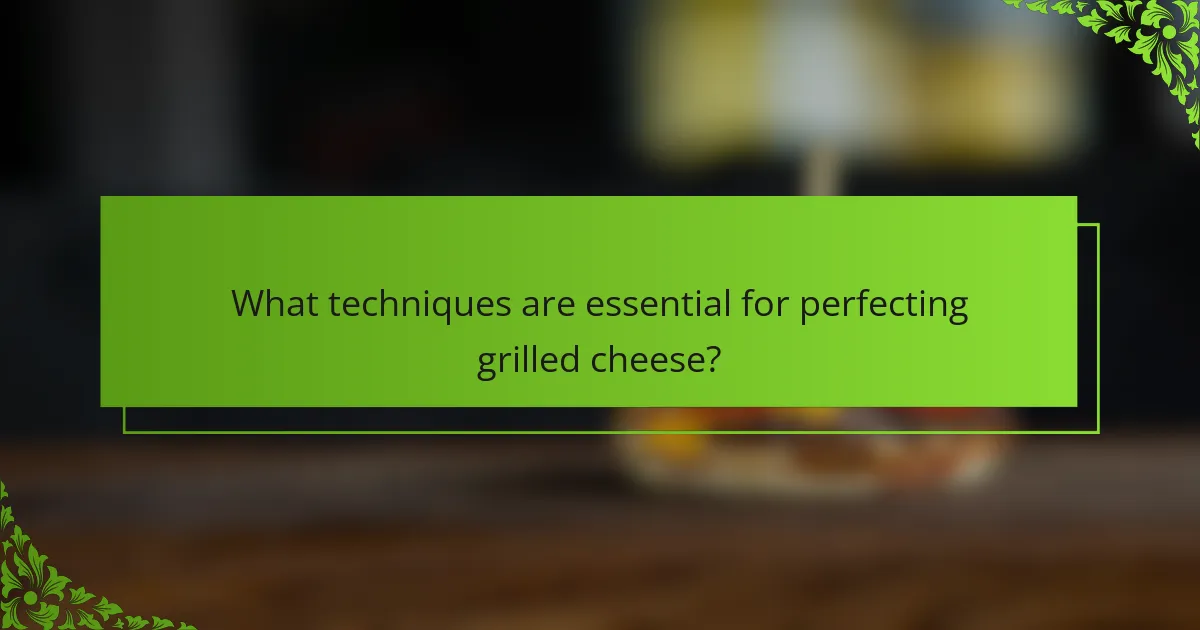The article focuses on the art of grilled cheese, detailing the essential techniques, tips, and tricks for creating the perfect sandwich. Key components include selecting the right bread, such as sourdough or whole grain, and choosing high-quality cheeses like cheddar or Gruyère for optimal melting and flavor. The cooking method emphasizes maintaining low to medium heat for even browning, buttering the bread for a golden crust, and using a lid to enhance cheese melting. Additional suggestions include experimenting with ingredients like tomatoes or bacon and carefully flipping the sandwich to maintain its structure. This comprehensive guide aims to elevate the grilled cheese experience through attention to detail and ingredient selection.

What is the art of grilled cheese?
The art of grilled cheese involves the precise technique of creating a perfectly toasted sandwich filled with melted cheese. This culinary skill requires selecting the right bread and cheese for optimal flavor and texture. Common choices for bread include sourdough, whole grain, and classic white. Popular cheese options include cheddar, American, and Gruyère, known for their melting properties.
The cooking method is crucial; maintaining a moderate heat ensures even browning without burning the bread. Buttering the outside of the bread enhances crispiness and flavor. Additionally, using a lid while cooking can help melt the cheese thoroughly.
The balance of ingredients, technique, and attention to detail in the cooking process defines the mastery of grilled cheese. This approach transforms a simple dish into a gourmet experience.
How did grilled cheese become a popular dish?
Grilled cheese became a popular dish during the Great Depression. Economic hardships made simple, affordable meals essential. Bread and cheese were widely available and inexpensive. The combination of these ingredients created a satisfying meal. The dish gained further popularity during World War II. Soldiers were served grilled cheese sandwiches due to their ease of preparation. Post-war, the rise of convenience foods solidified its place in American cuisine. Today, grilled cheese is celebrated for its comfort and versatility.
What historical influences shaped the grilled cheese sandwich?
The grilled cheese sandwich has historical influences from various cultures and culinary traditions. Its origins can be traced back to ancient times when bread and cheese were common staples. In the 1920s, the sandwich gained popularity in the United States with the advent of sliced bread. This innovation made the preparation of grilled cheese easier and more accessible. During the Great Depression, the sandwich became a cost-effective meal option. The combination of inexpensive ingredients appealed to many families. After World War II, processed cheese became widely available, further popularizing the grilled cheese sandwich. Today, it is a beloved comfort food in American cuisine.
What cultural variations exist for grilled cheese?
Cultural variations of grilled cheese include diverse ingredients and preparation methods. In the United States, it typically features American cheese between two slices of buttered bread. In France, the “croque monsieur” includes ham and béchamel sauce. In Italy, “pane e formaggio” uses local cheeses like mozzarella. In Mexico, “quesadilla” features cheese in a tortilla, often grilled. In Japan, “yaki onigiri” incorporates rice and cheese, grilled until crispy. Each variation reflects local tastes and traditions, showcasing the versatility of grilled cheese across cultures.
Why is mastering grilled cheese important for home cooks?
Mastering grilled cheese is important for home cooks because it enhances foundational cooking skills. This classic dish teaches essential techniques like proper heat management and ingredient pairing. A well-made grilled cheese showcases the balance of flavors and textures. Mastery of this dish can boost confidence in the kitchen. It serves as a versatile base for creativity, allowing for various fillings and styles. Additionally, grilled cheese is a comfort food that appeals to many, making it a staple in home cooking. According to a survey by the National Dairy Council, 92% of Americans enjoy grilled cheese sandwiches, highlighting their popularity.
What skills does making grilled cheese enhance?
Making grilled cheese enhances cooking skills, time management, and basic food safety. Cooking skills improve through the process of selecting ingredients, controlling heat, and mastering flipping techniques. Time management is developed as one must monitor cooking times to achieve the perfect melt without burning. Basic food safety is reinforced by ensuring proper handling of dairy products and maintaining cleanliness during preparation. These skills are foundational for more complex cooking tasks and can lead to greater culinary confidence.
How can grilled cheese elevate a meal experience?
Grilled cheese can elevate a meal experience by providing a comforting and satisfying flavor profile. This dish combines the richness of melted cheese with crispy, toasted bread. The contrast in textures enhances the overall enjoyment of the meal. Grilled cheese is versatile, allowing for various cheese types and additions like tomatoes or herbs. This adaptability caters to diverse taste preferences. Additionally, the aroma of toasting bread and melted cheese can stimulate appetite and create a welcoming atmosphere. Studies show that comfort foods, like grilled cheese, can improve mood and satisfaction during meals.

What techniques are essential for perfecting grilled cheese?
To perfect grilled cheese, use low to medium heat for even melting. This prevents burning while allowing the cheese to fully melt. Select the right bread; thicker slices hold up better. Use a combination of cheeses for depth of flavor. Butter the outside of the bread generously for a golden crust. Flip the sandwich carefully to avoid spilling the cheese. Cover the pan to trap heat and speed up melting. Cook until both sides are crispy and golden brown. These techniques ensure a delicious, well-textured grilled cheese sandwich.
How do different types of bread affect grilled cheese?
Different types of bread significantly affect the texture and flavor of grilled cheese. White bread creates a soft, mild sandwich with a crispy exterior when grilled. Whole grain bread offers a nuttier flavor and denser texture, enhancing the overall taste. Sourdough provides a tangy profile and chewy crust, adding complexity. Rye bread introduces a robust flavor, ideal for pairing with strong cheeses. Each bread type influences the melting properties of the cheese, impacting the overall mouthfeel. For instance, thicker breads may require longer grilling times to achieve the desired melt. The choice of bread can also alter the nutritional profile of the sandwich, affecting fiber and calorie content.
What are the best bread options for grilled cheese?
The best bread options for grilled cheese include sourdough, whole wheat, and white bread. Sourdough offers a tangy flavor and sturdy texture. Whole wheat provides a nutty taste and added fiber. White bread is soft and classic, yielding a crispy exterior when toasted. Rye bread is another option, adding a unique flavor profile. Each type of bread can enhance the grilled cheese experience. The choice depends on personal preference and desired flavor combinations.
How does the thickness of bread influence cooking time?
The thickness of bread directly influences cooking time. Thicker slices require longer cooking times to ensure even heating throughout. This is due to the need for heat to penetrate the bread fully. For example, a standard slice of bread cooks in about 2-4 minutes per side. In contrast, a thicker slice may take 5-7 minutes per side. The moisture content in thicker bread also affects cooking time. Higher moisture levels can slow down the cooking process. Therefore, adjusting cooking time based on bread thickness is essential for achieving optimal results.
What types of cheese work best for grilled cheese?
Cheddar, American, and Gruyère are the best cheeses for grilled cheese sandwiches. Cheddar offers a sharp flavor and melts well. American cheese provides a creamy texture and excellent meltability. Gruyère adds a nutty taste and a smooth melt. Combining these cheeses can enhance flavor and texture. For example, a blend of cheddar and Gruyère creates a rich, savory profile. The melting properties of these cheeses ensure a satisfying grilled cheese experience.
Which cheeses melt well for a creamy texture?
Cheeses that melt well for a creamy texture include mozzarella, cheddar, fontina, and Gruyère. Mozzarella has a high moisture content, which contributes to its smooth melting properties. Cheddar offers a rich flavor and melts beautifully, especially when aged. Fontina is known for its creamy consistency and excellent melting quality. Gruyère melts into a smooth, creamy texture, making it ideal for various dishes. These cheeses are commonly used in grilled cheese sandwiches for their desirable melting characteristics.
How can cheese combinations enhance flavor?
Cheese combinations enhance flavor by creating a balance of textures and tastes. Different cheeses have unique flavor profiles. For instance, sharp cheddar provides a tangy bite, while creamy brie adds smoothness. When combined, these cheeses can complement each other. The contrast between strong and mild flavors can elevate the overall taste experience. Additionally, melting properties vary among cheeses. This can lead to a more enjoyable mouthfeel. A study by the Dairy Research Institute highlights that cheese pairings can intensify flavor perception. This illustrates how thoughtful combinations can lead to a richer culinary experience.
What cooking methods can be used for grilled cheese?
Grilled cheese can be made using several cooking methods. The most common method is using a skillet or frying pan. This method allows for even heat distribution and browning. Another method is using a griddle, which can cook multiple sandwiches at once. A toaster oven can also be used, providing consistent heat from all sides. Additionally, an electric sandwich maker can create perfectly sealed sandwiches. Broiling in an oven is another option, allowing for a crispy top. Each method offers unique textures and flavors, enhancing the grilled cheese experience.
How does stovetop cooking compare to oven baking?
Stovetop cooking involves direct heat application, while oven baking uses indirect heat. Stovetop cooking allows for more immediate temperature control. This method is ideal for quick cooking tasks, such as melting cheese in a grilled cheese sandwich. Oven baking, on the other hand, provides even heat distribution. This is beneficial for achieving a crispy texture on the bread. According to the USDA, stovetop cooking can lead to faster meal preparation times. In contrast, baking may require longer cooking durations, typically 15 to 30 minutes for a grilled cheese. Each method has distinct advantages depending on the desired outcome.
What are the benefits of using a panini press?
A panini press provides several benefits for making grilled sandwiches. It evenly distributes heat, ensuring consistent cooking. The press creates a crispy exterior while keeping the interior moist. It also allows for cooking multiple sandwiches at once, saving time. The non-stick surface simplifies cleanup after use. Additionally, a panini press can be used for various types of bread and fillings, enhancing versatility in meal preparation. These advantages make it a valuable tool for grilled cheese enthusiasts.

What tips and tricks can enhance your grilled cheese recipe?
Use high-quality cheese for better flavor. Aged cheeses like cheddar or Gruyère melt well and add depth. Choose the right bread; sourdough or whole grain offers great texture. Butter the outside of the bread for a golden crust. Use a low heat to ensure even melting without burning. Experiment with additional ingredients like tomatoes or bacon for variety. Press the sandwich slightly while cooking to enhance browning. Flip carefully to maintain structure and prevent spillage. These tips improve taste, texture, and overall enjoyment of grilled cheese sandwiches.
How can you add flavor to your grilled cheese?
To add flavor to your grilled cheese, incorporate various ingredients and seasonings. Spreading garlic butter on the outside enhances taste. Using a mix of cheeses, like sharp cheddar and creamy mozzarella, creates depth. Adding sliced tomatoes or avocado offers freshness. Including cooked bacon or ham provides a savory element. Sprinkling herbs, such as basil or oregano, elevates the flavor profile. Experimenting with different breads, like sourdough or rye, adds unique characteristics. Each ingredient contributes distinct flavors, making your grilled cheese more delicious.
What are some popular add-ins or toppings for grilled cheese?
Popular add-ins or toppings for grilled cheese include tomatoes, bacon, and avocado. Tomatoes add freshness and acidity, enhancing the sandwich’s flavor. Bacon introduces a crispy texture and savory taste, making it more indulgent. Avocado provides creaminess and healthy fats, appealing to those seeking a nutritious option. Other common toppings are sautéed mushrooms, caramelized onions, and various cheeses. Sautéed mushrooms add umami, while caramelized onions offer sweetness. Different cheeses can create unique flavor profiles, such as sharp cheddar or creamy brie. These additions elevate the classic grilled cheese experience.
How can herbs and spices elevate the taste?
Herbs and spices enhance the taste of grilled cheese by adding complexity and depth. They introduce unique flavors that can transform a simple sandwich into a gourmet experience. For example, basil provides a fresh, aromatic quality, while smoked paprika adds a subtle heat. The use of garlic powder can impart a savory richness, and black pepper contributes a mild spiciness.
Studies show that flavor compounds in herbs and spices can stimulate the palate, making food more enjoyable. A 2016 study published in the journal “Food Quality and Preference” found that meals seasoned with herbs and spices are perceived as more flavorful and satisfying. This is because they can balance the richness of cheese and the bread, creating a harmonious taste profile.
What common mistakes should be avoided when making grilled cheese?
Common mistakes to avoid when making grilled cheese include using low-quality bread. Low-quality bread can lead to a soggy texture. Another mistake is using too little butter. Insufficient butter results in uneven browning. Overheating the pan is also a common error. High heat can burn the bread before the cheese melts. Additionally, not allowing the cheese to come to room temperature can hinder melting. Cold cheese takes longer to melt and may not achieve the desired gooeyness. Lastly, neglecting to cover the pan can lead to uneven cooking. Covering helps trap heat and ensures the cheese melts thoroughly.
How does cooking temperature affect the outcome?
Cooking temperature significantly affects the outcome of grilled cheese sandwiches. Higher temperatures can cause the bread to brown quickly while leaving the cheese unmelted. Conversely, lower temperatures allow the cheese to melt thoroughly but may result in undercooked or pale bread. Ideal cooking temperatures range between 325°F to 375°F. This range promotes even browning and proper melting of cheese. Cooking at these temperatures ensures a crispy exterior and a gooey interior. A study published in the Journal of Food Science highlights that temperature control is crucial for achieving the desired texture and flavor in grilled sandwiches.
What are signs of an improperly cooked grilled cheese?
Signs of an improperly cooked grilled cheese include uneven browning and raw cheese. The bread may appear burnt on the outside while remaining soggy inside. Inadequate melting of the cheese is also a clear indicator. The sandwich might feel cold or lukewarm when cut in half. Additionally, if the bread is overly greasy, it suggests improper cooking techniques. These signs indicate that the cooking temperature or time was not appropriate, leading to an unsatisfactory grilled cheese experience.
What are the best practices for serving grilled cheese?
Serve grilled cheese sandwiches immediately after cooking. Freshly made sandwiches retain optimal texture and flavor. Cut sandwiches diagonally for easier handling and presentation. Pair with tomato soup for a classic combination. Offer various dipping sauces to enhance taste. Use a warm plate to keep sandwiches hot longer. Garnish with fresh herbs for visual appeal. Serve with sides like pickles or chips for added variety.
How can presentation enhance the dining experience?
Presentation enhances the dining experience by making food visually appealing. A well-presented dish can stimulate appetite and create anticipation. Studies show that visual aesthetics can influence taste perception. For example, a 2017 study published in the journal Appetite found that food served on elegant plates was perceived as more delicious. Additionally, creative plating can showcase the chef’s skills and attention to detail. This can lead to a more memorable meal. Overall, presentation plays a crucial role in elevating the dining experience.
What side dishes pair well with grilled cheese?
Tomato soup pairs well with grilled cheese. This classic combination enhances the flavors of both dishes. The acidity of the tomato soup complements the richness of the cheese. A side salad also works well, providing freshness and crunch. A simple green salad adds a light contrast to the meal. Pickles can be a tangy addition, balancing the creaminess of the sandwich. Sweet potato fries offer a unique twist, adding sweetness and texture. These side dishes create a well-rounded dining experience with grilled cheese.
The main entity of this article is grilled cheese, a classic sandwich that combines bread and melted cheese. The article provides a comprehensive overview of the techniques, tips, and tricks essential for perfecting grilled cheese recipes, including the selection of bread and cheese, cooking methods, and common mistakes to avoid. It also explores the historical context of grilled cheese, cultural variations, and the importance of mastering this dish for enhancing foundational cooking skills. Additionally, the article discusses how to elevate the meal experience through flavor combinations, presentation, and suitable side dishes.